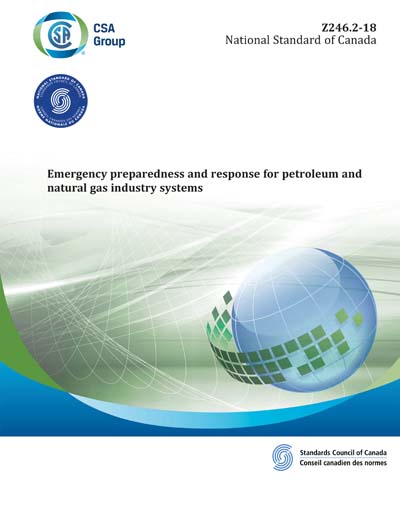Historical
CSA Z246.2-2018
Emergency preparedness and response for petroleum and natural gas industry systems
Preface This is the second edition of CSA Z246.2, Emergency preparedness and response for petroleum and natural gas industry systems. It supersedes the previous edition published in 2014. This Standard provides requirements for a continual improvement process to develop, implement, maintain, and evaluate an emergency preparedness and response program that helps operators in the industry to be prepared to respond to an emergency that affects people, the environment, or property. While this Standard provides requirements specific for an emergency preparedness and response program, it also acknowledges the use of the pillars of emergency management (EM); those being, prevention/mitigation, preparedness, response, and recovery within an organizations emergency and continuity management program, which is covered in in CSA Z1600. In developing this Standard, previous and existing standards were used. These include, but are not limited to, legislation, best practices, policies, standards, and applicable codes. This Standard has been developed in compliance with Standards Council of Canada requirements for National Standards of Canada. It has been published as a National Standard of Canada by CSA Group. Scope 1.1 This Standard establishes criteria for emergency preparedness and response for the petroleum and natural gas industry systems. Note: Prevention, continuity, and recovery are addressed in other standards. 1.2 This Standard applies to petroleum and natural gas industry systems (see Figures 1 and 2), including a) pipeline systems handling i) oil; ii) gas; iii) oil-field water; iv) liquid products; v) multi-phase fluids; vi) slurries; and vii) system supports, including 1) meter stations; 2) compressor stations; 3) pump stations; 4) tank farms; 5) terminals; and 6) all assets that support Items 1) to 5); b) liquefied natural gas (LNG) production, storage, and handling facilities; c) storage or disposal of hydrocarbons in underground formations; d) petrochemical installations, including i) refineries; ii) gas processing plants; iii) liquefied petroleum gas plants; iv) synthetic natural gas plants; and v) coal gasification plants; e) oil and gas exploration, development, production, treatment, processing, and storage operations not covered in Items a) to d); f) oil sands facilities; and g) petroleum and natural gas wells 1.3 This Standard does not apply to offshore petroleum and natural gas activity, petroleum and liquefied natural gas (LNG) tankers, nor customers piping system. Note: See Figures 1 and 2. 1.4 The requirements of this Standard are applicable to all operators, regardless of the size or number of their assets. 1.5 In this Standard, "shall" is used to express a requirement, i.e., a provision that the user is obliged to satisfy in order to comply with the standard; "should" is used to express a recommendation or that which is advised but not required; and "may" is used to express an option or that which is permissible within the limits of the Standard. Notes accompanying clauses do not include requirements or alternative requirements; the purpose of a note accompanying a clause is to separate from the text explanatory or informative material. Notes to tables and figures are considered part of the table or figure and may be written as requirements. Annexes are designated normative (mandatory) or informative (non-mandatory) to define their application.
Content Provider
CSA America, Inc. [csa]






